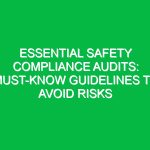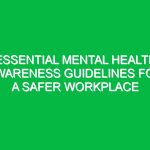“`html
Essential Mediation and Third-Party Involvement Guidelines for Safety
Good morning team! Today, we’re going to discuss a critical aspect of our Workplace Safety: Essential Mediation and Third-Party Involvement Guidelines for Safety. Understanding how mediation and third-party involvement work can significantly enhance our safety protocols and create a more secure work environment for everyone. Let’s dive in!
Understanding Essential Mediation and Third-Party Involvement Guidelines
So, what do we mean by Essential Mediation and Third-Party Involvement Guidelines for Safety? In the context of Workplace Safety, mediation refers to the process of resolving conflicts or disputes that arise between employees, supervisors, or between teams. Third-party involvement typically includes external organizations or professionals who can provide objective insights and solutions to enhance safety practices.
The importance of these guidelines cannot be overstated. They help in:
- Establishing clear communication channels.
- Resolving conflicts amicably, preventing escalation.
- Ensuring compliance with safety Regulations.
Every employee’s daily operations can be impacted by unresolved disputes or misunderstandings, which is why having these guidelines in place is essential. A common misconception is that mediation is only necessary for serious conflicts; however, even minor issues can escalate if not addressed promptly.
Key Hazards, Risks, and Safety Considerations
When we ignore the importance of mediation and third-party involvement, we expose ourselves to several risks, including:
- Increased Workplace Tension: Unresolved conflicts can lead to a toxic work environment.
- Safety Violations: Disputes may distract employees from adhering to safety protocols.
- Higher Turnover Rates: Employees may seek other jobs if they feel unsafe or unsupported.
Real-world consequences can be dire. For example, a construction company faced a significant safety incident because two teams were in conflict over project responsibilities, leading to miscommunication regarding Safety Measures. As a result, an employee was injured. This incident highlights the necessity of effective mediation and third-party involvement.
Best Practices, Procedures, & Actionable Advice
Here are some Best Practices to implement mediation and third-party involvement effectively:
Step-by-Step Safety Procedures
- Recognize the Conflict: Be aware of any tensions or disputes among team members.
- Initiate Open Communication: Encourage team members to express their concerns openly.
- Engage a Mediator: If necessary, involve a neutral third-party mediator to facilitate discussions.
- Follow-Up: Ensure that resolutions are implemented and monitor the situation for any further issues.
Practical Tips
Here are some practical tips to enhance your understanding of mediation:
- Stay Neutral: As an employee or supervisor, approach conflicts without bias.
- Listen Actively: Ensure all parties feel heard and understood during discussions.
- Document Everything: Keep records of discussions and resolutions for future reference.
Real-World Example
Consider a scenario in which a supervisor notices a recurring disagreement between two team members regarding Safety Gear use. By addressing the issue through mediation, the supervisor facilitates a discussion that clarifies the safety protocols and ensures everyone is on the same page, ultimately preventing future disputes.
Regulations, Standards, and Compliance
Understanding relevant regulations and compliance Standards is crucial when it comes to effective mediation and safety practices. The Occupational Safety and Health Administration (OSHA) provides guidelines that mandate safe work environments, including the need for conflict resolution mechanisms. Compliance with these regulations protects employees and reduces the risk of legal repercussions for the company.
Adhering to safety protocols not only ensures Workplace Safety but also fosters a culture of accountability and transparency. Remember, safety is everyone’s responsibility, and understanding the guidelines for mediation helps us create a safer work environment.
Employee Engagement & Discussion
Now, I would like to open the floor for discussion. Here are a few questions to consider:
- What safety challenges have you encountered related to conflicts in the workplace?
- Can you share an experience where mediation helped resolve a safety issue?
- How can we improve our conflict resolution processes to enhance Workplace Safety?
Your feedback is invaluable. Let’s share our experiences and learn from each other!
Conclusion & Key Takeaways
In summary, understanding Essential Mediation and Third-Party Involvement Guidelines for Safety is crucial for maintaining a safe and productive work environment. Remember to:
- Recognize and address conflicts early.
- Engage in open communication.
- Utilize mediation when necessary.
By prioritizing these practices, we can foster a culture of safety and cooperation. Thank you for your commitment to safety and for your attention today. Let’s work together to keep our workplace safe and supportive!
“`


